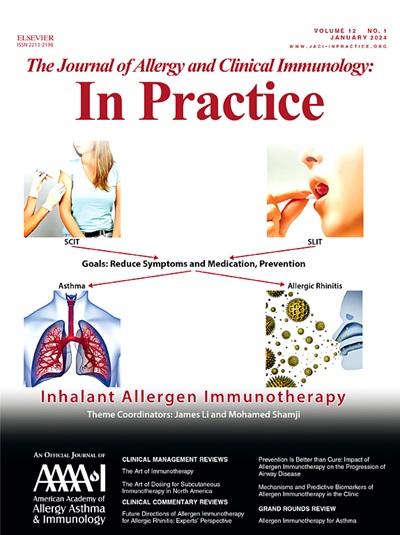慢性自发性荨麻疹的鉴别诊断。
IF 6.6
1区 医学
Q1 ALLERGY
Journal of Allergy and Clinical Immunology-In Practice
Pub Date : 2025-09-01
DOI:10.1016/j.jaip.2025.06.019
引用次数: 0
摘要
慢性复发性荨麻疹患者最常被诊断为慢性自发性荨麻疹,尽管根据某些“危险信号”可以怀疑一些自身免疫、自身炎症和恶性疾病。这些“危险信号”包括:轮期持续时间为100 ~ 24小时、炎症后色素沉着、全身症状,如关节痛、发烧和/或炎症标志物升高。在此,我们详细介绍了一个最初诊断为CSU的成年患者的病例,讨论了可能的鉴别诊断,并概述了诊断确定后治疗患者的选择。我们强调需要仔细检查实验室和组织学结果以及其他调查,包括血清免疫固定电泳和基因检测。本文章由计算机程序翻译,如有差异,请以英文原文为准。
Differential Diagnosis of Chronic Spontaneous Urticaria
Patients with chronic recurrent wheals most commonly receive the diagnosis of chronic spontaneous urticaria, although a number of autoimmune, autoinflammatory, and malignant diseases can be suspected based on certain red flags. These warning signs are a wheal duration of more than 24 hours, post-inflammatory hyperpigmentation, and systemic symptoms such as arthralgia and fever and/or elevated inflammatory markers. Here, we detail the case of an adult patient who initially received the diagnosis of chronic spontaneous urticaria, discussing possible differential diagnoses and outlining options for treating the patient once a diagnosis has been established. We highlight the need for a careful examination of laboratory and histologic findings and other investigations, including serum immunofixation electrophoresis and genetic testing.
求助全文
通过发布文献求助,成功后即可免费获取论文全文。
去求助
来源期刊

Journal of Allergy and Clinical Immunology-In Practice
ALLERGYIMMUNOLOGY-IMMUNOLOGY
CiteScore
11.10
自引率
9.60%
发文量
683
审稿时长
50 days
期刊介绍:
JACI: In Practice is an official publication of the American Academy of Allergy, Asthma & Immunology (AAAAI). It is a companion title to The Journal of Allergy and Clinical Immunology, and it aims to provide timely clinical papers, case reports, and management recommendations to clinical allergists and other physicians dealing with allergic and immunologic diseases in their practice. The mission of JACI: In Practice is to offer valid and impactful information that supports evidence-based clinical decisions in the diagnosis and management of asthma, allergies, immunologic conditions, and related diseases.
This journal publishes articles on various conditions treated by allergist-immunologists, including food allergy, respiratory disorders (such as asthma, rhinitis, nasal polyps, sinusitis, cough, ABPA, and hypersensitivity pneumonitis), drug allergy, insect sting allergy, anaphylaxis, dermatologic disorders (such as atopic dermatitis, contact dermatitis, urticaria, angioedema, and HAE), immunodeficiency, autoinflammatory syndromes, eosinophilic disorders, and mast cell disorders.
The focus of the journal is on providing cutting-edge clinical information that practitioners can use in their everyday practice or to acquire new knowledge and skills for the benefit of their patients. However, mechanistic or translational studies without immediate or near future clinical relevance, as well as animal studies, are not within the scope of the journal.
 求助内容:
求助内容: 应助结果提醒方式:
应助结果提醒方式:


